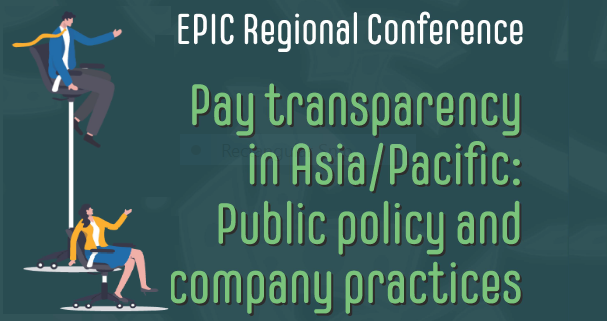EPIC REGIONAL CONFERENCE – PAY TRANSPARENCY IN ASIA/PACIFIC: PUBLIC POLICY AND COMPANY PRACTICES
Date: Wednesday, 26 October 2022
Time: 7:30 – 9:30 CET, 14:30 – 16:30 JST, 15:30-17:30 ACT, 17:30 – 19:30 NZDT
Language: English and Japanese
Registration link: https://bit.ly/3TmYerS
Gender differences in labour market outcomes across Asia and the Pacific remain pronounced. Younger generations have progressively reduced and often reversed the gender gap in educational attainment. This has contributed to the narrowing of gender employment and pay gaps. Nevertheless, there remain substantial differences in terms and conditions of employment between men and women. The reasons for these differences are manifold and include, social institutions, attitudes, and norms, hiring practices, access to career opportunities, while in many countries the motherhood penalty is considerable. Indeed, despite existing labour market and family policies to support fathers and mothers to fulfil their family and labour market aspirations, it can be difficult for mothers to resume their career after taking some time out looking after very young children. The inequality in earnings has long-lasting consequences throughout the life course. It restricts women’s economic empowerment and contributes to relatively high poverty risks for women of retirement age.
To reduce persistent gender wage gaps and more specifically raise awareness about systematic pay differences within firms, pay transparency measures have gained momentum in policy packages over the past decade. The goal of such measures is to encourage employers to prevent, and address pay inequity, to give workers and their representatives more information to combat pay discrimination, and to help governments identify when, where, and how to target gender wage gaps. Governments from this region and beyond have shown initiative and creativity in designing these policies.
• In Japan, from July 2022, private companies that employ more than 300 employees are required to disclose women’s pay as a percentage of men’s, on their website or elsewhere, breaking down the figures by permanent and non-permanent employees. Any legitimate reason for gender pay disparities will need to be provided.
• In Australia, organizations must submit data on six Gender Equality Indicators to the federal Agency (WGEA), which then calculates gender pay gaps. Workers are told the size of the gap, but the public is only told whether a company complied with reporting.
• In Korea, companies are required to report gender-disaggregated data on workforce characteristics but not gender pay gap data. Unless workplaces must undertake affirmative action. Since 2020 all such workplaces are required to submit data on their gender pay gap status, the underlying cause and a plan to address the issue.
• New Zealand does not have public pay reporting in place, but they have an innovative approach towards establishing “work of equal value.” The Equal Pay Act requires that payments for the same or substantially similar work make no differentiation based on the worker’s sex. In pay equity claims, factors to be considered when undertaking a work assessment include skills, responsibilities, work conditions and effort, and New Zealand has also made it easier to pursue a pay equity claim by ensuring courts are a last-resort option after negotiations between workers, unions, and employers.
In this regional conference, governments, employers, workers, and their organizations from the Asia/Pacific region will share their experiences, policies, and practices to make equal pay between women and men for work of equal value a reality, with a particular focus on pay transparency.
Find out more by downloading the agenda (below).
